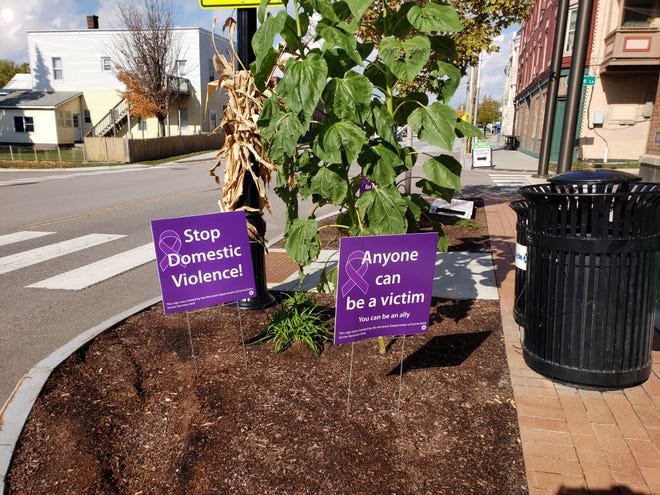November 10, 2021 | Burlington Free Press
Elizabeth Murray, Public Safety Reporter
Domestic violence is the cause of at least 50% of Vermont’s homicides each year.
This trend was recently highlighted once again after a man told police he killed his wife during a trip to Bolton for their one-year wedding anniversary in October, court papers show.
Parents of the woman, Emily Jean Ferlazzo, 22, say they had noticed possible signs of domestic violence during the relationship, but they were never able to confirm the abuse. The husband, Joseph Ferlazzo, 41, has been charged with first-degree murder, and he has pleaded not guilty.
Domestic violence situations are often complex and cannot necessarily be solved with a simple call to the police. The Burlington Free Press conducted an email Q&A with Karen Tronsgard-Scott, the executive director of the Vermont Network Against Domestic and Sexual Violence, to highlight red flags that may allude to a domestic violence situation, misconceptions about these situations, and ways a survivor’s loved ones can offer support.
‘Domestic violence is insidious’: Emily Ferlazzo’s family on a life cut short by homicide

Burlington Free Press: What situations fall under the umbrella of domestic violence?
Karen Tronsgard-Scott: In Vermont, domestic assault is defined as any person who attempts to cause, or willfully or recklessly causes bodily injury to a family or household member, or willfully causes a family or household member to fear imminent serious bodily injury. So that means that domestic violence can happen between intimate partners, parents and children, and other household members. It also means that domestic violence, under Vermont law, includes actual physical harm or the imminent threat of harm.
BFP: Who are most often the victims of domestic violence in Vermont?
KTS: In Vermont, as is true across the country, the majority of victims of domestic violence are female-identified people. Domestic violence certainly can happen to male-identified people as well as people who identify as other genders.

BFP: What are some of the common misconceptions about domestic violence?
KTS: There are many misconceptions about domestic violence. I’ll list the top four in my experience:
- “Domestic violence is about anger and/or substance use.” People who use violence in their relationships are attempting to control their victim and their environment. They may appear to be angry, however, they have not “lost it.” The appearance of anger is a tactic used to maintain power and control. They may use alcohol and/or drugs, however those substances do not cause the violence. They can exacerbate it.
- “Victims should just leave.” Leaving a relationship is never easy. Leaving a relationship in which the partner uses violence and coercion poses all the challenges present in leaving any relationship with the added reality that leaving is incredibly dangerous. Victims are far more likely to be seriously harmed or killed when they leave an abusive relationship — after all, the abusive partner is focused on controlling the victim. When the victim leaves, this represents a serious, profound loss of that control.
- “Victims lie about being abused.” There simply is no evidence that this is true.
- “Firearms present no heightened risk in violent homes.” In fact, the presence of firearms in a home where there is domestic violence significantly increases the risk of serious harm or death.
Grants for two programs:Vermont Community Foundation supports programs for domestic violence victims
BFP: How pervasive is this issue in Vermont?
KTS: Vermonters experience domestic violence at rates similar to other states. On average, 8,000 Vermonters are served by the fifteen member organizations of the Vermont Network each year. What does set Vermont apart from other states is our domestic violence homicide rate.
For more than a decade, just over 50% of all homicides in Vermont have been related to domestic violence. This includes an abusive partner killing a victim as well as murder/suicides. Of those homicides, over 50% involve a firearm. This nexus of violence and firearms creates significant risk for victims of domestic violence and in some years, positions Vermont as one of the most dangerous states, per capita, in the country when it comes to domestic violence homicides.
BFP: What are some of the warning signs or red flags that may indicate a person is in a dangerous or violent situation?
KTS: Obvious signs are unexplained or suspicious physical injuries.
Over time, victims may become more and more isolated from friends and family.
Also, injuries to children and pets.

BFP: What does it take for a person to leave this situation?
KTS: It is important to understand that violence may not define this relationship. Victims of domestic violence know the whole person with whom they are in a relationship. It is important to support victims who are interested in leaving and victims who want to stay.
BFP: How can friends and family members support a person who might be experiencing domestic violence? Is there anything that friends and family members should avoid doing that might further harm the situation? Your stories live here.Fuel your hometown passion and plug into the stories that define it.Create Account
Steps to End Domestic Violence:New domestic violence shelter to arrive in Chittenden County
KTS: Listening without judging is important. Expressing support for someone who may be in an abusive relationship, even if they will not talk about it. Follow their lead – victims of domestic violence know what they are doing and are the experts at their lives.
I think an equally important question is what should someone do if they suspect a friend or a family member is using violence. We have to be able to say hard things to these folks, like “I am worried about you and how I’m seeing you treat your wife. Can we talk about this?” There are programs available to people who use violence throughout our state. People can change but they will need support to do that.
BFP: What are some resources through which survivors and their loved ones can get additional support?
KTS: The Vermont Network at vtnetwork.org has an interactive map for finding local help. In Chittenden County, Steps to End Domestic Violence (stepsvt.org) is the local domestic violence services organization.
There is also a statewide domestic violence hotline: 800-228-7395.
To view this story in its original form, Click Here.


Comments